Some users have encountered an issue where Microsoft Edge fails to play sound. The videos that they play on Edge on YouTube, Netflix, and other social media platforms have no sound. According to them, the issue persists only in Edge. They can hear sound in other web browsers, like Chrome, Firefox, etc. In this article, we will see some solutions to fix the no sound issue in Microsoft Edge. If you encounter this issue in Edge, you can try these solutions to make things normal again.
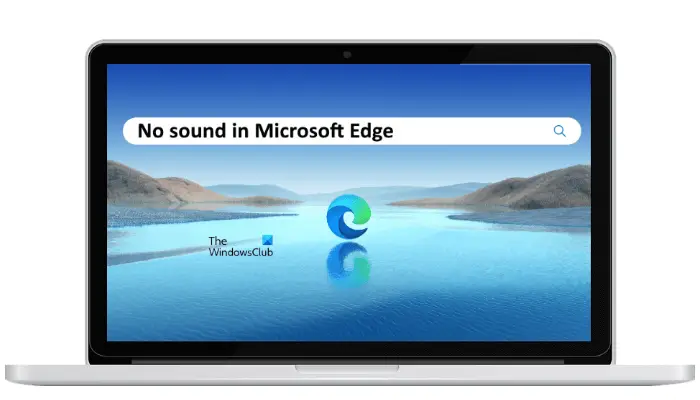
No sound in Microsoft Edge
First, restart the Microsoft Edge browser and see if it helps. Also, check if the tab in Edge is muted or not. If the tab is muted, you will not hear the sound by playing videos on Edge. You can use the Ctrl + M keys to mute and unmute the tabs in Edge. If this does not work, try the solutions provided below:
- Set your audio device as the default
- Check Volume Mixer settings
- Turn off the Exclusive Mode for your audio device
- Uninstall and reinstall your audio device driver
- Run Playing Audio Troubleshooter
- Clear Edge cache and cookie data
- Disable Audio Enhancements
- Create a new profile in Edge
- Repair Edge
- Reset Edge settings to default.
Let’s see all these fixes in detail.
1] Set your audio device as the default
Check if you have set your audio device as the default or not. The following steps will help you with that.
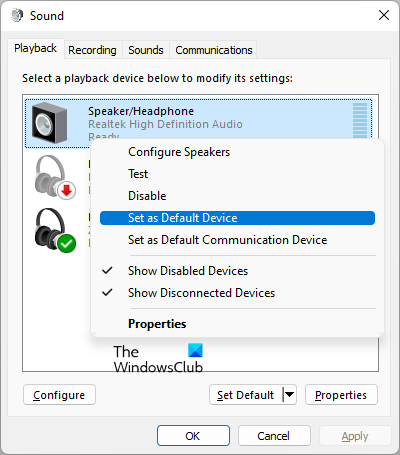
- Open the Control Panel.
- Switch the View by mode to Large icons.
- Click Sound.
- Under the Playback tab, right-click on your audio device and select Set as Default Device.
- Click OK.
Now, check if the issue persists. If yes, try the next potential fix.
2] Check Volume Mixer settings
When you play a video in the Microsoft Edge browser, it appears in the Volume Mixer in Windows. You can block Edge from playing sound for any video by muting it in the Volume Mixer settings. Check if Edge is muted in Volume Mixer or not. The following steps will help you with that:
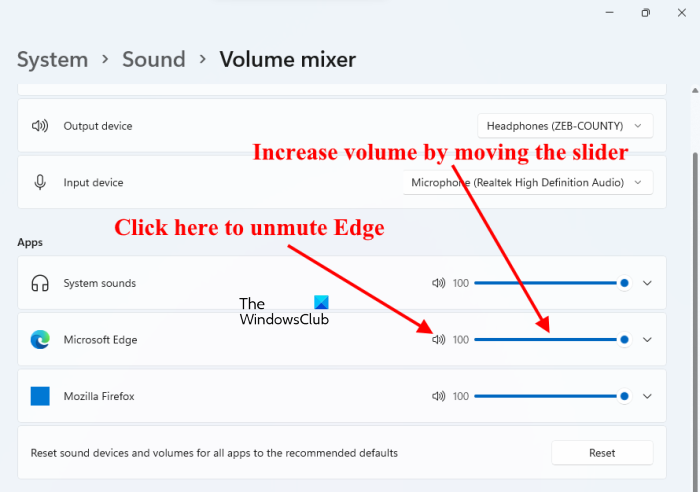
- Open YouTube or any other platform to play a video in Microsoft Edge.
- Right-click on the sound icon on your Taskbar.
- Select Open Volume Mixer.
- The speaker icon next to the Microsoft Edge should not be muted. If so, click on it again to unmute Edge.
- Move the slider to increase volume in Microsoft Edge.
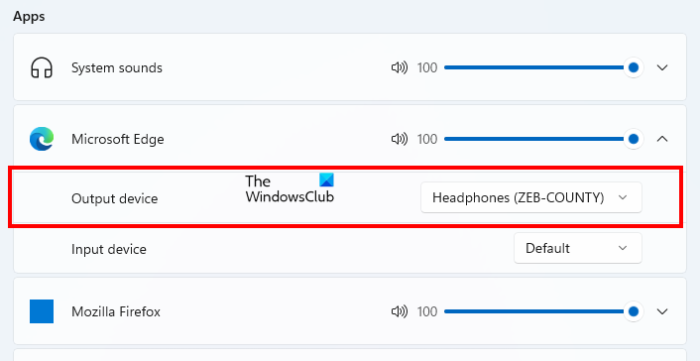
If this does not work, check if you have selected the right audio device for Edge in Volume Mixer. Click on the Microsoft Edge tab on the Volume Mixer page in Windows 11/10 Settings and select the right audio output device.
3] Turn off the Exclusive Mode for your audio device
Turning off the Exclusive Mode for the audio device fixed the issue for many users. You should also try this. Maybe it will work for you too. The steps to do that are as follows:
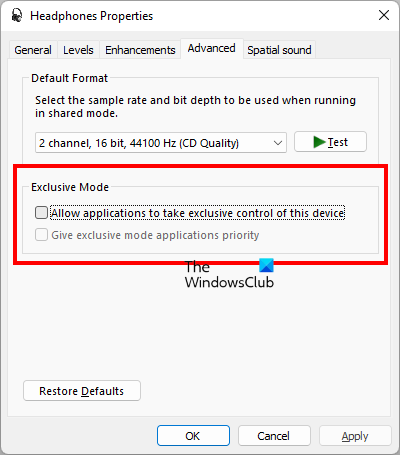
- Open the Control Panel.
- Set the View by mode to Large icons.
- Right-click on your audio device and select Properties.
- In the Properties window, go to the Advanced tab.
- Uncheck both the options under the Exclusive Mode section (see the above screenshot).
If this does not work, there may be an issue with your audio driver.
4] Uninstall and reinstall your audio device driver
It is possible that your audio device driver is corrupted. Drivers establish a connecting link between the hardware device and the operating system. When the driver gets corrupted, the respective hardware device does not work properly. Such types of problems can be fixed by updating or reinstalling the affected device driver. The following steps will help you.
- Press the Win + X keys and select the Device Manager.
- In the Device Manager, expand the Audio inputs and outputs node.
- Right-click on your audio device driver and select Uninstall device.
- Visit the manufacturer’s website, download the latest version of your audio device, and install it manually. Or restart your computer to let Windows install the missing driver automatically.
After reinstalling the audio device driver, check if you can hear sound in Edge by playing a video.
5] Run Playing Audio Troubleshooter
Because you are experiencing audio issues on Edge, running the Playing Audio Troubleshooter can solve the problem. The steps to run the Playing Audio Troubleshooter are listed below:
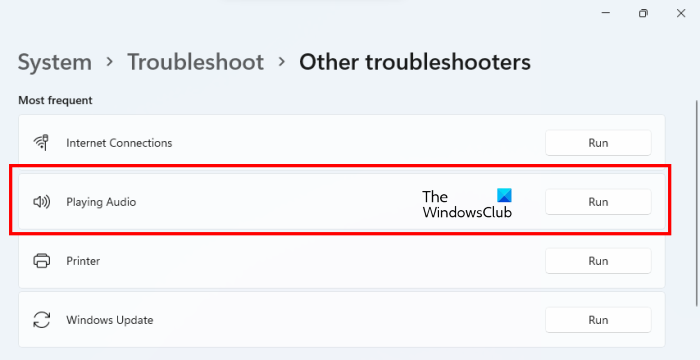
- Open Windows 11/10 Settings.
- Go to “System > Troubleshoot > Other troubleshooters.”
- Select the Playing Audio troubleshooter and click Run.
After running the troubleshooter, the issue should get fixed.
6] Clear Edge cache and cookie data
Bad cache and cookie data cause several problems in a web browser. A cache is a software component that stores data to make future requests quicker. If you experience issues with your web browser, the reason for this may be corrupted cache and cookies.
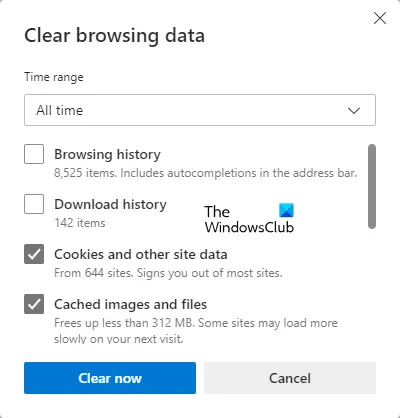
Clearing Edge cache and cookies can resolve the issue. To do so, open Edge and press the Ctrl + Shift + Delete keys. Now, delete cache and cookies.
7] Disable Audio Enhancements
Sometimes, Audio Enhancements create audio issues on a Windows computer. Disabling this feature can resolve the issue. The steps are as follows:
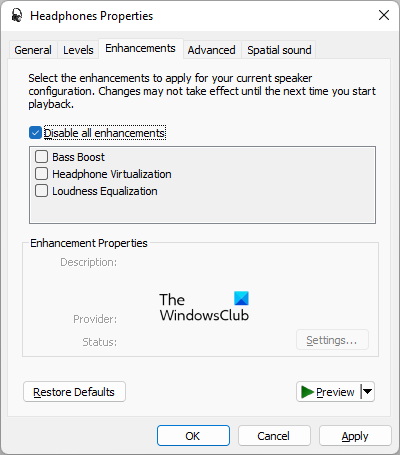
- Open the Control Panel.
- Switch the View by mode to Large icons and select Sound.
- Right-click on your audio device and select Properties.
- Go to the Enhancements tab and select the Disable all enhancements checkbox.
- Click Apply and then click OK.
8] Create a new profile in Edge
Sometimes, the problem persists in a specific user profile in Edge. To check if this is the case with you, create a new user profile in Edge. If this works, you can import bookmarks from your old profile to the new profile. Go through the following steps to create a new profile in Edge:
- Open Microsoft Edge.
- Click on your profile icon on the top right side and select Add profile.
- Now, click Add.
Check if the problem is fixed. If yes, delete your old profile and sign into your new profile with the same Microsoft account. This will restore all your data including settings, saved passwords, bookmarks, etc. Or, you can manually import bookmarks to the new profile from the old profile.
9] Repair Edge
When you start experiencing glitches on a particular app, you can repair it via Windows 11/10 Settings. This action may fix the issues you are facing. The no sound issue can be fixed by repairing Microsoft Edge.
10] Reset Edge settings to default
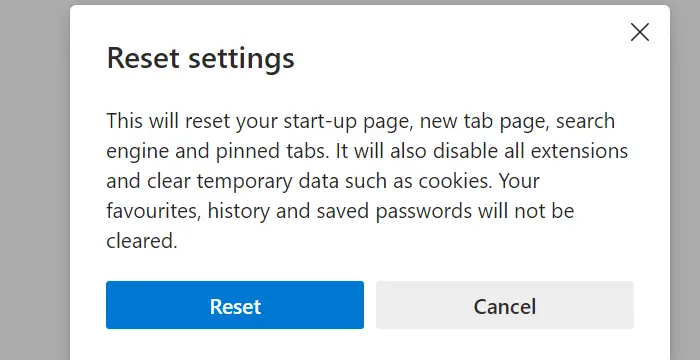
It is possible that you or another user (if you have a shared computer) has changed the Edge settings by mistake due to which Edge is not playing audio. In this case, resetting the Edge settings to default will fix the problem. This action will reset your start-up page, new tab page, search engine, and pinned tabs. Your favorites, history, and saved passwords will not be cleared.
11] Uninstall the latest Windows Update
If the issue started occurring after updating your system, uninstalling the recent Windows Update will help. You can uninstall a Windows Update via Windows 11/10 Settings.
12] Perform a System Restore
System Restore is a tool that helps protect your system. When you turn it on, it takes a snapshot of the Windows Registry and system files. When a problem occurs, you can restore your system to the previous working state by running the System Restore tool.
Read: Not enough memory to open this page, says Microsoft Edge.
Why is my sound not working in Microsoft Edge?
If your sound is not working in Microsoft Edge, check your Volume Mixer settings. Edge does not play a sound if you have muted it in Volume Mixer. Other causes of this issue are corrupted or outdated audio device driver, corrupted cache and cookies, corrupted user profile, etc.
How do I unmute my browser Edge?
The Ctrl + M keys are used to mute a tab in Microsoft Edge. Press these keys again to unmute the muted tab in Edge. If your tab is already unmuted but still you are not hearing sound in Edge, check your Volume Mixer settings. Also, check whether you have selected the correct audio device for Edge in Volume Mixer. Apart from that, you can also try updating your audio device driver, clearing Edge cache and cookies, etc.
I hope this helps.
Read next: How to fix flashing black screen in Microsoft Edge.
Leave a Reply